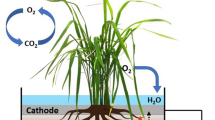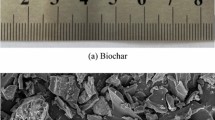Abstract
Plant microbial fuel cell (PMFC) newly emerges as a sustainable technology in green infrastructures such as green roofs, reactive barriers, and environmental biosensors. PMFCs generate bioelectricity driven by microbial redox reactions in the rhizosphere. However, the interactions between the bioelectricity and soil–water characteristics remain unknown, and PMFCs are vulnerable to drought stress. Therefore, this study aims to reveal the coupled bio-hydrological behaviors of PMFCs and propose biochar amendment on PMFCs for improving bioelectricity generation under drought conditions. Biochar-aided PMFCs were prepared by growing green-roof vegetation, Hydrocotyle vulgaris, on sandy lean clay with biochar at a mass ratio of 0, 5, and 10%. Bioelectricity (i.e., electrical potential and current) and unsaturated soil properties (i.e., suction and water content) were monitored simultaneously. Results showed that biochar increased the electrical power output of PMFCs by up to 30 times in unsaturated conditions. This may be because biochar-enhanced catalytic activities in redox reactions decreased soil electrical resistance and improved water retention. The bioelectricity was highly correlated with the suction, as the bioelectrical potential and current decreased by 90% with increasing suction. It was also found that the bioelectrical potential dropped rapidly by 67.6–87.2% when suctions were larger than the air entry values. This might be because air invasion led to the discontinuity of the liquid phase, hindering the ion transport of microbial redox reactions. The study implies that bioelectricity could be applied for field monitoring of soil–water characteristics, and biochar addition would enhance the drought resistance of PMFCs.











Similar content being viewed by others
Data availability
Data are available upon reasonable request.
References
Abbas SZ, Rafatullah M (2021) Recent advances in soil microbial fuel cells for soil contaminants remediation. Chemosphere 272:129691. https://doi.org/10.1016/j.chemosphere.2021.129691
Al Qabany A, Soga K, Santamarina C (2012) Factors affecting efficiency of microbially induced calcite precipitation. J Geotech Geoenviron Eng 138(8):992–1001. https://doi.org/10.1061/(ASCE)GT.1943-5606.0000666
Alves AC, de Souza ER, de Melo HF et al (2022) Comparison of solution extraction methods for estimating electrical conductivity in soils with contrasting mineralogical assemblages and textures. CATENA 218:106581. https://doi.org/10.1016/j.catena.2022.106581
Archie GE (1942) The electrical resistivity log as an aid in determining some reservoir characteristics. Trans AIME 146(01):54–62. https://doi.org/10.2118/942054-G
ASTM D2487–11 (2020) Standard practice for classification of soils for engineering purposes (Unified Soil Classification System). ASTM, West Conshohocken. https://doi.org/10.1520/D2487-17E01
ASTM D4318–17 (2018) Standard test methods for liquid limit, plastic limit, and plasticity index of soils. ASTM, West Conshohocken. https://doi.org/10.1520/D4318-17E01
Bais HP, Weir TL, Perry LG, Gilroy S, Vivanco JM (2006) The role of root exudates in rhizosphere interactions with plants and other organisms. Annu Rev Plant Biol 57(1):233–266. https://doi.org/10.1146/annurev.arplant.57.032905.105159
Boldrin D, Leung AK, Bengough AG (2021) Hydro-mechanical reinforcement of contrasting woody species: a full-scale investigation of a field slope. Géotechnique 71(11):970–984. https://doi.org/10.1680/jgeot.19.SiP.018
Cai W, Bordoloi S, Ng CWW, Sarmah AK (2022) Influence of pore fluid salinity on shrinkage and water retention characteristics of biochar amended kaolin for landfill liner application. Sci Total Environ. https://doi.org/10.1016/j.scitotenv.2022.156493
Cheng TH, Ching KB, Uttraphan C, Heong YM (2020) Electrical energy production from plant biomass: an analysis model development for pandanus amaryllifolius plant microbial fuel cell. Indones J Electr 18(3):1163–1171. https://doi.org/10.11591/ijeecs.v18.i3.pp1163-1171
Chiranjeevi P, Mohanakrishna G, Mohan SV (2012) Rhizosphere mediated electrogenesis with the function of anode placement for harnessing bioenergy through CO2 sequestration. Bioresour Technol 124:364–370. https://doi.org/10.1016/j.biortech.2012.08.020
Ewing T, Ha PT, Beyenal H (2017) Evaluation of long-term performance of sediment microbial fuel cells and the role of natural resources. Appl Energy 192:490–497. https://doi.org/10.1016/j.apenergy.2016.08.177
Fornero JJ, Rosenbaum M, Cotta MA, Angenent LT (2010) Carbon dioxide addition to microbial fuel cell cathodes maintains sustainable catholyte pH and improves anolyte pH, alkalinity, and conductivity. Environ Sci Technol 44(7):2728–2734. https://doi.org/10.1021/es9031985
Garg A, Bordoloi S, Ni J, Cai W, Maddibiona PG, Mei G, Poulsen TG, Lin P (2019) Influence of biochar addition on gas permeability in unsaturated soil. Geotech Lett 9(1):66–71. https://doi.org/10.1680/jgele.18.00190
Genuchten MT van (1980) A closed-form equation for predicting the hydraulic conductivity of unsaturated soils. Soil Sci Soc Am J 44(5):892–898. https://doi.org/10.2136/sssaj1980.03615995004400050002x
Guan CY, Tseng YH, Tsang DC, Hu A, Yu CP (2019) Wetland plant microbial fuel cells for remediation of hexavalent chromium contaminated soils and electricity production. J Hazard Mater 365:137–145. https://doi.org/10.1016/j.jhazmat.2018.10.086
Gul S, Whalen JK, Thomas BW, Sachdeva V, Deng H (2015) Physico-chemical properties and microbial responses in biochar-amended soils: mechanisms and future directions. Agric Ecosyst Environ 206:46–59. https://doi.org/10.1016/j.agee.2015.03.015
Habibul N, Hu Y, Sheng GP (2016) Microbial fuel cell driving electrokinetic remediation of toxic metal contaminated soils. J Hazard Mater 318:9–14. https://doi.org/10.1016/j.jhazmat.2016.06.041
Helder M, Strik DPBTB, Hamelers HVM, Kuijken RCP, Buisman CJN (2012) New plant-growth medium for increased power output of the Plant-Microbial Fuel Cell. Bioresour Technol 104:417–423. https://doi.org/10.1016/j.biortech.2011.11.005
Helder M, Strik DP, Timmers RA, Raes SM, Hamelers HV, Buisman CJ (2013) Resilience of roof-top plant-microbial fuel cells during Dutch winter. Biomass Bioenergy 51:1–7. https://doi.org/10.1016/j.biombioe.2012.10.011
Indraratna B, Medawela S, Rowe RK, Thamwattana N, Heitor A (2020) Biogeochemical clogging of permeable reactive barriers in acid-sulfate soil floodplain. J Geotech Geoenviron Eng 146(5):04020015. https://doi.org/10.1061/(ASCE)GT.1943-5606.0002231
Kabutey FT, Zhao Q, Wei L, Ding J, Antwi P, Quashie FK, Wang W (2019) An overview of plant microbial fuel cells (PMFCs): Configurations and applications. Renew Sust Energ Rev 110:402–414. https://doi.org/10.1016/j.rser.2019.05.016
Keiluweit M, Nico PS, Johnson MG, Kleber M (2010) Dynamic molecular structure of plant biomass-derived black carbon (biochar). Environ Sci Technol 44(4):1247–1253. https://doi.org/10.1021/es9031419
Khorshidi M, Lu N (2017) Intrinsic relation between soil water retention and cation exchange capacity. J Geotech Geoenviron Eng 143(4):04016119. https://doi.org/10.1061/(ASCE)GT.1943-5606.0001633
Khorshidi M, Lu N (2017) Quantification of exchangeable cations using soil water retention curve. J Geotech Geoenviron Eng 143(9):04017057. https://doi.org/10.1061/(ASCE)GT.1943-5606.0001732
Kim BH, Chang IS, GilG C, Park HS, Kim HJ (2003) Novel BOD (biological oxygen demand) sensor using mediator-less microbial fuel cell. Biotechnol Lett 25(7):541–545. https://doi.org/10.1023/A:1022891231369
Kolton M, Graber ER, Tsehansky L, Elad Y, Cytryn E (2017) Biochar-stimulated plant performance is strongly linked to microbial diversity and metabolic potential in the rhizosphere. New Phytol 213(3):1393–1404. https://doi.org/10.1111/nph.14253
Kuiper I, Lagendijk EL, Bloemberg GV, Lugtenberg BJ (2004) Rhizoremediation: a beneficial plant-microbe interaction. Mol Plant Microbe Interact 17(1):6–15. https://doi.org/10.1094/MPMI.2004.17.1.6
Kumar SS, Kumar V, Kumar R, Malyan SK, Pugazhendhi A (2019) Microbial fuel cells as a sustainable platform technology for bioenergy, biosensing, environmental monitoring, and other low power device applications. Fuel 255:115682. https://doi.org/10.1016/j.fuel.2019.115682
Lawson K, Rossi R, Regan JM, Logan BE (2020) Impact of cathodic electron acceptor on microbial fuel cell internal resistance. Bioresour Technol 316:123919. https://doi.org/10.1016/j.biortech.2020.123919
Lee Y, Ryu C, Park YK, Jung JH, Hyun S (2013) Characteristics of biochar produced from slow pyrolysis of Geodae-Uksae 1. Bioresour Technol 130:345–350. https://doi.org/10.1016/j.biortech.2012.12.012
Liu WJ, Jiang H, Yu HQ (2015) Development of biochar-based functional materials: toward a sustainable platform carbon material. Chem Rev 115(22):12251–12285. https://doi.org/10.1021/acs.chemrev.5b00195
Liu SH, Lai CY, Ye JW, Lin CW (2018) Increasing removal of benzene from groundwater using stacked tubular air-cathode microbial fuel cells. J Clean Prod 194:78–84. https://doi.org/10.1016/j.jclepro.2018.05.138
Liu L, Lu Y, Fu Y, Horton R, Ren T (2022) Estimating soil water suction from texture, bulk density and electrical resistivity. Geoderma 409:115630. https://doi.org/10.1016/j.geoderma.2021.115630
Logan BE, Regan JM (2006) Electricity-producing bacterial communities in microbial fuel cells. Trends Microbiol 14(12):512–518. https://doi.org/10.1016/j.tim.2006.10.003
Lu N, Likos WJ (2006) Suction stress characteristic curve for unsaturated soil. J Geotech Geoenviron Eng 132(2):131–142. https://doi.org/10.1061/(ASCE)1090-0241(2006)132:2(131)
Lu L, Xing D, Ren ZJ (2015) Microbial community structure accompanied with electricity production in a constructed wetland plant microbial fuel cell. Bioresour Technol 195:115–121. https://doi.org/10.1016/j.biortech.2015.05.098
Maddalwar S, Nayak KK, Kumar M, Singh L (2021) Plant microbial fuel cell: opportunities, challenges, and prospects. Bioresour Technol 341:125772. https://doi.org/10.1016/j.biortech.2021.125772
Martinez A, Dejong J, Akin I, Aleali A, Arson C, Atkinson J, Zheng J et al (2022) Bio-inspired geotechnical engineering: principles, current work, opportunities and challenges. Géotechnique 72(8):687–705. https://doi.org/10.1680/jgeot.20.P.170
Mitchell JK (1991) Conduction phenomena: from theory to geotechnical practice. Geotechnique 41(3):299–340. https://doi.org/10.1680/geot.1991.41.3.299
Mitchell JK, Santamarina JC (2005) Biological considerations in geotechnical engineering. J Geotech Geoenviron Eng 131(10):1222–1233. https://doi.org/10.1061/(ASCE)1090-0241(2005)131:10(1222)
Mohan SV, Srikanth S, Raghuvulu SV, Mohanakrishna G, Kumar AK, Sarma PN (2009) Evaluation of the potential of various aquatic eco-systems in harnessing bioelectricity through benthic fuel cell: effect of electrode assembly and water characteristics. Bioresour Technol 100(7):2240–2246. https://doi.org/10.1016/j.biortech.2008.10.020
Nitisoravut R, Regmi R (2017) Plant microbial fuel cells: a promising biosystems engineering. Renew Sust Energ Rev 76:81–89. https://doi.org/10.1016/j.rser.2017.03.064
Park J, Santamarina JC (2020) The critical role of pore size on depth-dependent microbial cell counts in sediments. Sci Rep 10(1):1–7. https://doi.org/10.1038/s41598-020-78714-3
Rabaey K, Verstraete W (2005) Microbial fuel cells: novel biotechnology for energy generation. Trends Biotechnol 23(6):291–298. https://doi.org/10.1016/j.tibtech.2005.04.008
Ramezanian A, Dahlin AS, Campbell CD, Hillier S, Mannerstedt-Fogelfors B, Öborn I (2013) Addition of a volcanic rockdust to soils has no observable effects on plant yield and nutrient status or on soil microbial activity. Plant Soil 367(1):419–436. https://doi.org/10.1007/s11104-012-1474-2
Reddy KR, Yargicoglu EN, Yue D, Yaghoubi P (2014) Enhanced microbial methane oxidation in landfill cover soil amended with biochar. J Geotech Geoenviron Eng 140(9):04014047. https://doi.org/10.1061/(ASCE)GT.1943-5606.0001148
Rosenbaum M, He Z, Angenent LT (2010) Light energy to bioelectricity: photosynthetic microbial fuel cells. Curr Opin Biotechnol 21(3):259–264. https://doi.org/10.1016/j.copbio.2010.03.010
Rusyn I (2021) Role of microbial community and plant species in performance of plant microbial fuel cells. Renew Sust Energy Rev 152:111697. https://doi.org/10.1016/j.rser.2021.111697
Smith JL, Collins HP, Bailey VL (2010) The effect of young biochar on soil respiration. Soil Biol Biochem 42(12):2345–2347. https://doi.org/10.1016/j.soilbio.2010.09.013
Soil Survey Staff (2014) Keys to soil taxonomy. USDA-Natural Resources Conservation Service, Washington DC. https://www.nrcs.usda.gov/wps/portal/nrcs/detail/soils/survey/class/taxonomy/?cid=nrcs142p2_053580#illustrated
Strik DP, Hamelers HVM, Snel JF, Buisman CJ (2008) Green electricity production with living plants and bacteria in a fuel cell. Int J Energy Res 32(9):870–876. https://doi.org/10.1002/er.1397
Tapia NF, Rojas C, Bonilla CA, Vargas IT (2017) A new method for sensing soil water content in green roofs using plant microbial fuel cells. Sensors 18(1):71. https://doi.org/10.3390/s18010071
Tapia NF, Rojas C, Bonilla CA, Vargas IT (2017) Evaluation of Sedum as driver for plant microbial fuel cells in a semiarid green roof ecosystem. Ecol Eng 108:203–210. https://doi.org/10.1016/j.ecoleng.2017.08.017
Taşkan B (2020) Increased power generation from a new sandwich-type microbial fuel cell (ST-MFC) with a membrane-aerated cathode. Biomass Bioenergy 142:105781. https://doi.org/10.1016/j.biombioe.2020.105781
Wani I, Ramola S, Garg A, Kushvaha V (2021) Critical review of biochar applications in geoengineering infrastructure: moving beyond agricultural and environmental perspectives. Biomass Convers Biorefin. https://doi.org/10.1007/s13399-021-01346-8
Warnock DD, Lehmann J, Kuyper TW, Rillig MC (2007) Mycorrhizal responses to biochar in soil–concepts and mechanisms. Plant Soil 300(1):9–20. https://doi.org/10.1007/s11104-007-9391-5
Xiao N, Selvaganapathy PR, Wu R, Huang JJ (2020) Influence of wastewater microbial community on the performance of miniaturized microbial fuel cell biosensor. Bioresour Technol 302:122777. https://doi.org/10.1016/j.biortech.2020.122777
Yargicoglu EN, Reddy KR (2018) Biochar-amended soil cover for microbial methane oxidation: effect of biochar amendment ratio and cover profile. J Geotech Geoenviron Eng 144(3):04017123. https://doi.org/10.1061/(ASCE)GT.1943-5606.0001845
Zhu H, Indupriya M, Gadi VK, Sreedeep S, Mei GX, Garg A (2020) Assessment of the coupled effects of vegetation leaf and root characteristics on soil suction: an integrated numerical modeling and probabilistic approach. Acta Geotech 15(5):1331–1339. https://doi.org/10.1007/s11440-019-00801-1
Zhu H, Zhang LM (2016) Field investigation of erosion resistance of common grass species for soil bioengineering in Hong Kong. Acta Geotech 11(5):1047–1059. https://doi.org/10.1007/s11440-015-0408-6
Acknowledgements
Authors would like to express their sincere gratitude to National Natural Science Foundation of China (Grant No. 41907252) for its support.
Author information
Authors and Affiliations
Corresponding author
Additional information
Publisher's Note
Springer Nature remains neutral with regard to jurisdictional claims in published maps and institutional affiliations.
Rights and permissions
Springer Nature or its licensor (e.g. a society or other partner) holds exclusive rights to this article under a publishing agreement with the author(s) or other rightsholder(s); author self-archiving of the accepted manuscript version of this article is solely governed by the terms of such publishing agreement and applicable law.
About this article
Cite this article
Chen, B., Cai, W. & Garg, A. Relationship between bioelectricity and soil–water characteristics of biochar-aided plant microbial fuel cell. Acta Geotech. 18, 3529–3542 (2023). https://doi.org/10.1007/s11440-022-01787-z
Received:
Accepted:
Published:
Issue Date:
DOI: https://doi.org/10.1007/s11440-022-01787-z




